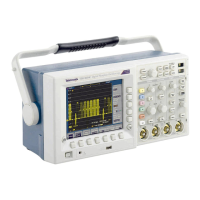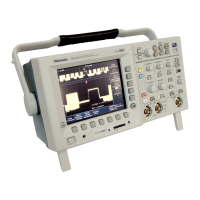Reference
Finding Cursors. When using zoom , delay, or the fastest t im e base
settings, the cursors can go off screen. If you want to fi nd them, use the
Bring Both Cursors On Screen function to move them onto the screen.
Fine Cursor Movement. W hen you magnify the waveform with the zoom
function, you can easily set the cursor to any point on the waveform.
Δ4.16V
@-1.78V
Δ6.32V
@3.16V
Δ5.86μs
@1.06μs
Horizontal bar cursors Vertical bar cursors
Δ Readout.
The Δ readouts indicate the difference between the cursor
positions.
@ Readout. For H Bar or V Bar cursors, the voltage readout after the @
symbol indicates the location of the active cursor relative to zero volts.
For V Bar cursors, the time readout after the @ symbol indicates the
location of the active cursor relative to the trigger point.
Cursor Interaction with Previe w. If you change a vertical or horizontal
control setting while acquisition is stopped or it is waiting for trigger,
the cursors move w ith the waveforms and cursor measurements remain
valid.
Taking Gray-Scale M easurements. Using cur sors is o ft en the b e st wa y
to take simple measurements on waveforms that contain significant
gray-scale information. The automatic measurements operate only on
the latest acquisition, not on the previous acquisitions that are displayed
in gray scale. However, you can set the cursors to surround and measure
thegray-scaleareaofthewaveform.
CursorsatSamePosition. If both cursors a re at the same position, and H
Bars or V Bars are set to Ratio or Phase, both cursors are set to 0% (or
0°). 100%/360° is set to one pixel wid th away from the cu rsor position.
V Bars and FFT. When the selected waveform is an FFT waveform,
selecting V Bars and Phase sets the measurement to percent.
72 TDS3000C Series Oscilloscope User Manual

